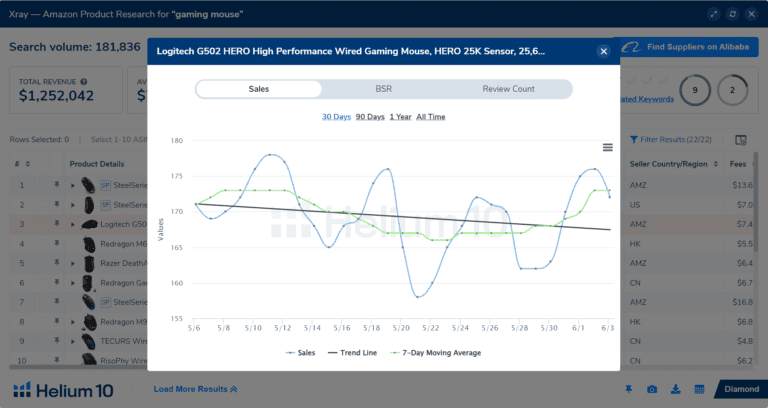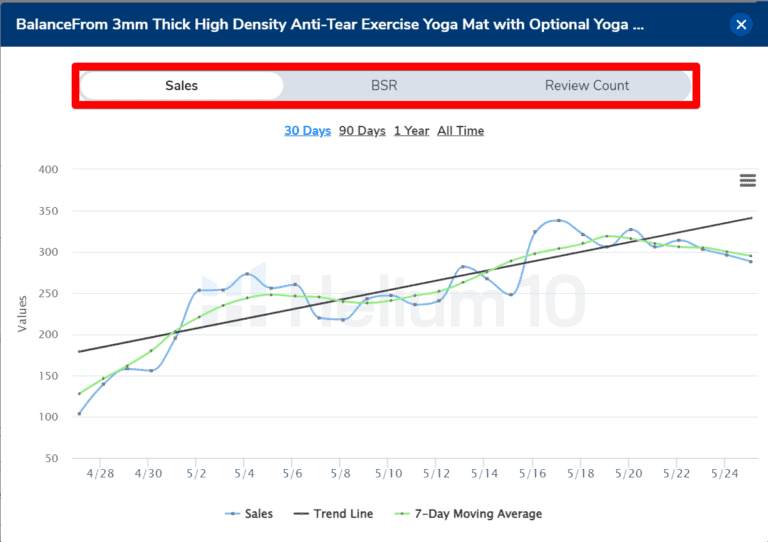As an experienced blogger, I’ve delved deep into the world of Amazon selling tools. One tool that has caught my attention is Helium 10, known for its powerful features that can skyrocket your sales. Today, I’ll be focusing on the Helium 10 sales graph, a vital component for any Amazon seller looking to track their performance effectively.
When it comes to analyzing sales data, the Helium 10 sales graph stands out for its user-friendly interface and comprehensive insights. Understanding your sales trends is crucial for making informed decisions and maximizing your profits on the platform.
In this article, I’ll walk you through how to interpret and leverage the Helium 10 sales graph to boost your revenue and stay ahead of the competition.
What is Helium 10 Sales Graph?
The Helium 10 Sales Graph is a vital tool for Amazon sellers to track their performance metrics, such as revenue, units sold, and profits over time. It presents this data in an easy-to-understand graphical format, allowing sellers to monitor trends and identify patterns in their sales history.

Importance of Sales Graphs in Helium 10:
Sales graphs in Helium 10 are essential for sellers to analyze their sales data, spot fluctuations, and make informed decisions based on trends. Understanding these graphs enables sellers to optimize their strategies, adjust pricing, and focus on high-selling products to maximize profits.
How to Access the Sales Graph Feature?
- Log In: Start by logging in to your Helium 10 account using your credentials.
- Navigate to Dashboard: After logging in, you’ll be directed to the dashboard. If not, find and click on the “Dashboard” option in the menu.
- Locate Sales Graph Tab: On the dashboard, locate the Sales Graph tab. It’s usually displayed prominently, often in the form of a graph icon or labeled as “Sales Graph.”
- Click on the Sales Graph Tab: Once you’ve found the Sales Graph tab, click on it to access the feature.
- Customize Date Range: Within the Sales Graph feature, you’ll typically have options to customize the date range. Choose the desired period for which you want to view sales data.
- Apply Filters: Depending on the capabilities of the Sales Graph feature, you may have the option to apply filters to the data. This allows you to focus on specific metrics or segments of your sales data.
- View Metrics: After customizing the date range and applying any filters, you’ll be able to view various metrics related to your Amazon sales performance. These metrics may include sales revenue, units sold, profit margins, and more.
By following these steps, you can easily access the Sales Graph feature in your Helium 10 account and gain valuable insights into your Amazon sales performance.
Interpreting the Sales Graph:
When analyzing the Sales Graph, I focus on revenue, units sold, and profits. The data is presented visually, making it easier for me to grasp the overall performance at a glance.
Identifying Trends and Patterns:
By closely examining the Sales Graph, I can spot trends and patterns such as seasonal fluctuations or changing consumer preferences. This insight helps me adjust my strategies and capitalize on opportunities.
Improving Sales Performance with Helium 10:
I’ve found that utilizing the Sales Graph feature provides invaluable insights into my sales performance. The ability to analyze revenue, units sold, and profits at a glance helps me make informed decisions quickly.

By identifying trends and patterns within the Sales Graph, I can adapt my strategies to capitalize on opportunities and maximize my sales on Amazon.
Implementing Strategies for Growth:
When it comes to Improving Sales Performance, I rely on the data-driven approach enabled by the Sales Graph. By interpreting the data effectively, I can develop targeted strategies to boost my sales.
Whether it’s adjusting pricing, launching promotions, or introducing new products, the insights from the Sales Graph empower me to make decisions that drive growth.
Conclusion:
The Sales Graph feature in Helium 10 is a powerful tool for gaining valuable insights into sales performance. By analyzing revenue, units sold, and profits, I can quickly identify trends and make informed decisions to drive growth.
Implementing data-driven strategies, such as adjusting pricing and launching promotions based on Sales Graph data, can lead to increased profitability and market competitiveness.
With the ability to track performance metrics and make real-time adjustments, Helium 10’s Sales Graph feature is essential for any e-commerce business looking to optimize its sales strategies.
Frequently Asked Questions:
The Sales Graph is a tool in Helium 10 that provides insights into sales performance, including revenue, units sold, and profits, to help sellers make informed decisions.
By using the Sales Graph feature, you can quickly identify trends and patterns in your sales data, allowing you to adjust pricing, launch promotions, and introduce new products for business growth.
Data-driven strategies, like leveraging the Sales Graph, empower sellers to make informed decisions promptly, leading to more effective business choices and improved sales performance.
